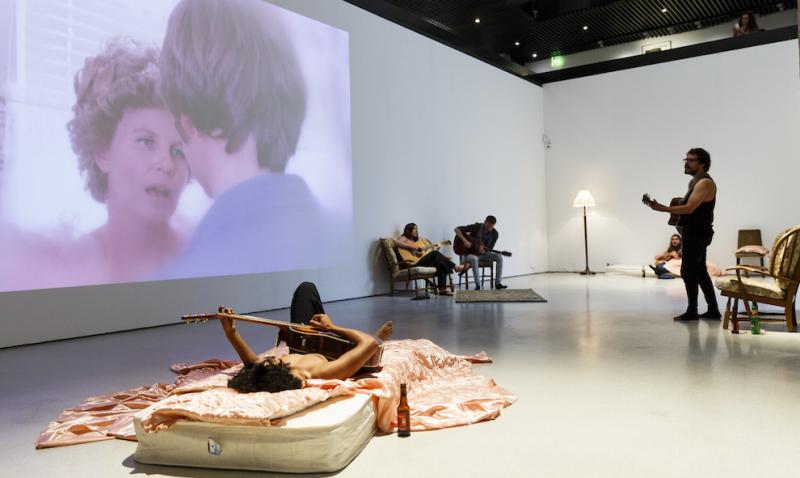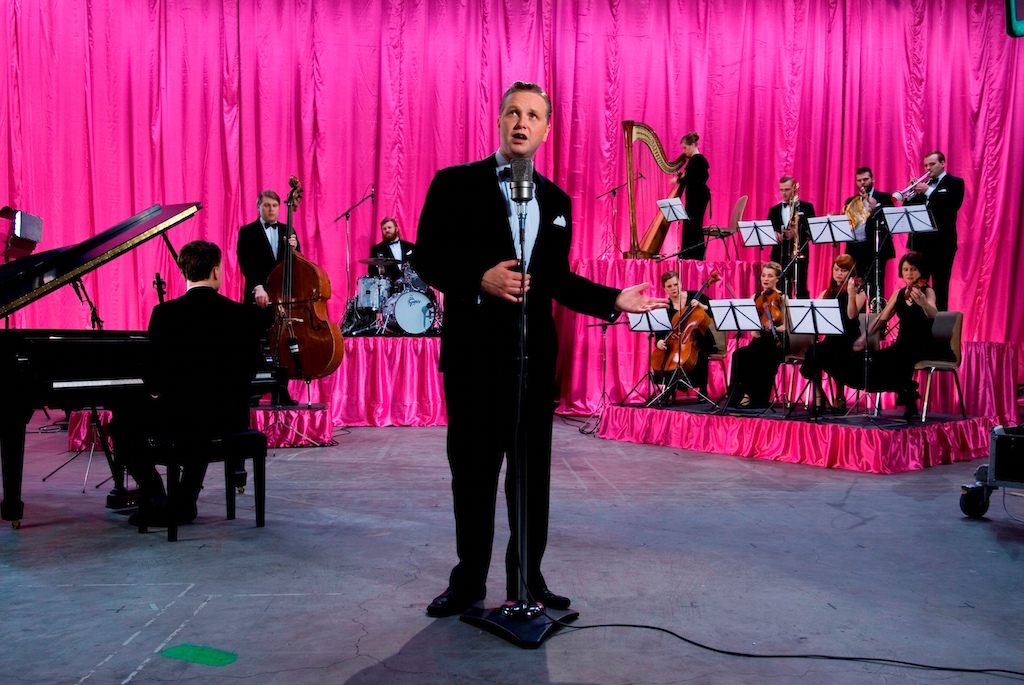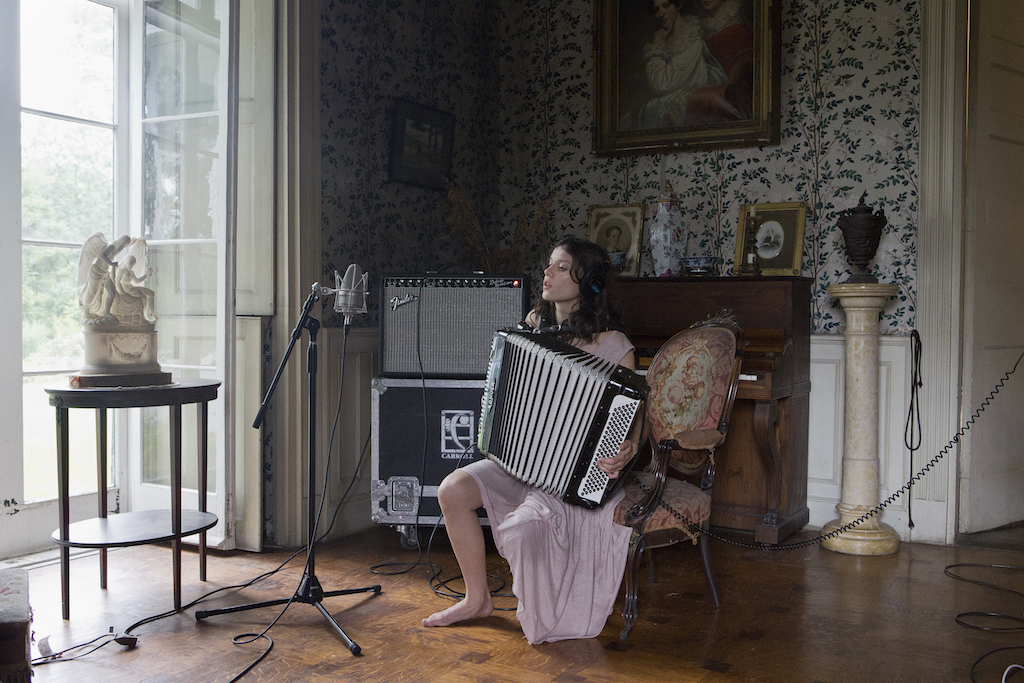Ragnar Kjartansson, Barbican Art Gallery | reviews, news & interviews
Ragnar Kjartansson, Barbican Art Gallery
Ragnar Kjartansson, Barbican Art Gallery
Fact and fiction coalesce in work by an artist born into an acting dynasty

A neon sign over the Barbican’s Silk Street entrance reads Scandinavian Pain. Following its victory over us in Euro 16, it seems that Iceland is now drenching us with its special brand of melancholy. Things are not that simple, of course. In his work, Icelandic artist Ragnar Kjartansson indulges his penchant for sorrow with such bitter sweetness that, with many a gentle sigh, emotional pain morphs into something more akin to pleasure.
In any case, he is hard pressed to distinguish real emotion from its ersatz other, since he was born into an acting dynasty and, as a child, spent many hours watching from the wings as his mother and father portrayed the imagined feelings of numerous fictional characters. His parents met on the set of Murder Story, a film shot in 1975. Projected large onto the wall of the gallery is a clip showing Kjartansson’s mother, Guôrún Ásmundsdóttir (Iceland’s equivalent of Judy Dench), dreaming of an erotic encounter with the plumber, played by her future husband (main picture). Vaseline smeared onto the lens gives the sordid little scene a glimmer of fake romance, as the bored housewife rips off the tradesman’s shirt while urgently whispering, “Take me here by the dishwasher.” Since family mythology has it that the artist was conceived mid-production, the sex scene that follows could well be a precursor to his actual conception. Fact and tawdry fiction intertwine to a fascinating degree.
Ten guitarists lounge around the gallery on the kind of furniture seen in the film. For eight hours at a stretch, they sing snippets of the dialogue that intertwine to produce a melancholy ditty about loneliness, lust and longing and the romantic clichés that nurture them. While many of us have a soft spot for silver screen soppiness, few can claim direct descent from a celluloid romance that continued between the sheets in real life. Take me here...is, then, a meditation on the way popular culture and celebrity romances influence our ideas about love, while also being a celebration of the artist’s own origins. Permeating the entire exhibition space, the maudlin harmonies create a mood of languid eroticism that is unlikely ever to find satisfaction.
 Given his background, its scarcely surprising that Kjartansson seems to inhabit a twilight zone in which the real and the fictional intertwine. Across the pages of a notebook, he has written “Is this real life”; and no matter what medium he adopts, his work explores the relationship between drama and genuine feeling.
Given his background, its scarcely surprising that Kjartansson seems to inhabit a twilight zone in which the real and the fictional intertwine. Across the pages of a notebook, he has written “Is this real life”; and no matter what medium he adopts, his work explores the relationship between drama and genuine feeling.
In the video God, 2007 (pictured above) he assumes the persona of a tuxedo-wearing crooner with slicked-back hair and a cheesy grin. Red satin curtains line the room; they match the copious drapes framing the set on which an orchestra strikes up a schmaltzy ballad and Kjartansson sings Sorrow conquers happiness. He repeats this solemn mantra over and over for half an hour until, eventually, embracing sorrow begins to feel like a welcome relief from the false cheeriness that travels across the Atlantic with other American imports.
A Lot of Sorrow, 2014 is a beautifully atmospheric video of the American indie band, The National, repeatedly performing Sorrow from their album High Violet during a six-hour stint for a live audience at MoMa PS1 in New York. As lead singer Matt Berninger intones for the umpteenth time “Sorrow found me when I was young/ Sorrow waited, sorrow won”, painful memories seem to accrue and assume an almost ecstatic intensity.
The Visitors, 2012 (pictured below) was shot in Rokeby Farm, a crumbling mansion in upstate New York crammed with antiques and fine furniture. A group of musician friends from Reykjavik took up residence, one to a room, and in a nine-screen installation we see them simultaneously playing their instruments and singing the refrain “Once again I fall into my feminine ways”. The title of the piece comes from the last album made by ABBA before their split, and the hour-long performance of this melancholy chorus seems to reprise the gradual breakdown of a relationship.
Ultimately, though, the mood is upbeat. After their solitary explorations of failure, the musicians gather on the lawn and wander off together into the landscape. Watching them disappear across the fields, I was reminded of Antoine Watteau’s painting Embarkation for Cythera, 1719, showing a group of young people setting off to party on the mythic Greek island of love.
During his stay at Rokeby, Kjartansson also explored the mythic image of the plein-air painter in a performance that was recorded in black and white photographs and as a clutch of feeble landscape paintings. He undertook a similar project for the Venice Biennale of 2009. Day after day for six months, the artist made paintings of his friend Páll Haukur Björnsson smoking, drinking beer, strumming a guitar or gazing at the Grand Canal through the windows of a 14th century palazzo.
The notion of picture making as a performance is not new, of course (think of Jackson Pollock), but the product has usually been as important as the process. Acting as a painter is one thing, producing the goods is quite another and, unfortunately, Kjartansson has no skills as a draughtsman. Whereas every detail of his videos is carefully considered and beautifully executed so the misery they purvey is transformed into sheer delight, his paintings are poor enough to undermine the cleverest concept. This is one instance in which the merging of fact and fiction is not amenable to fudge. You could say it is Ragnar Kjartansson’s Nemesis, the moment in which reality strikes back.
rating
Explore topics
Share this article
Add comment
The future of Arts Journalism
You can stop theartsdesk.com closing!
We urgently need financing to survive. Our fundraising drive has thus far raised £49,000 but we need to reach £100,000 or we will be forced to close. Please contribute here: https://gofund.me/c3f6033d
And if you can forward this information to anyone who might assist, we’d be grateful.

Subscribe to theartsdesk.com
Thank you for continuing to read our work on theartsdesk.com. For unlimited access to every article in its entirety, including our archive of more than 15,000 pieces, we're asking for £5 per month or £40 per year. We feel it's a very good deal, and hope you do too.
To take a subscription now simply click here.
And if you're looking for that extra gift for a friend or family member, why not treat them to a theartsdesk.com gift subscription?
more Visual arts
 'We are bowled over!' Thank you for your messages of love and support
Much-appreciated words of commendation from readers and the cultural community
'We are bowled over!' Thank you for your messages of love and support
Much-appreciated words of commendation from readers and the cultural community
 Folkestone Triennial 2025 - landscape, seascape, art lovers' escape
Locally rooted festival brings home many but not all global concerns
Folkestone Triennial 2025 - landscape, seascape, art lovers' escape
Locally rooted festival brings home many but not all global concerns
 Sir Brian Clarke (1953-2025) - a personal tribute
Remembering an artist with a gift for the transcendent
Sir Brian Clarke (1953-2025) - a personal tribute
Remembering an artist with a gift for the transcendent
 Emily Kam Kngwarray, Tate Modern review - glimpses of another world
Pictures that are an affirmation of belonging
Emily Kam Kngwarray, Tate Modern review - glimpses of another world
Pictures that are an affirmation of belonging
 Kiefer / Van Gogh, Royal Academy review - a pairing of opposites
Small scale intensity meets large scale melodrama
Kiefer / Van Gogh, Royal Academy review - a pairing of opposites
Small scale intensity meets large scale melodrama
 Jenny Saville: The Anatomy of Painting, National Portrait Gallery review - a protégé losing her way
A brilliant painter in search of a worthwhile subject
Jenny Saville: The Anatomy of Painting, National Portrait Gallery review - a protégé losing her way
A brilliant painter in search of a worthwhile subject
 Abstract Erotic, Courtauld Gallery review - sculpture that is sensuous, funny and subversive
Testing the boundaries of good taste, and winning
Abstract Erotic, Courtauld Gallery review - sculpture that is sensuous, funny and subversive
Testing the boundaries of good taste, and winning
 Edward Burra, Tate Britain review - watercolour made mainstream
Social satire with a nasty bite
Edward Burra, Tate Britain review - watercolour made mainstream
Social satire with a nasty bite
 Ithell Colquhoun, Tate Britain review - revelations of a weird and wonderful world
Emanations from the unconscious
Ithell Colquhoun, Tate Britain review - revelations of a weird and wonderful world
Emanations from the unconscious
 Rachel Jones: Gated Canyons, Dulwich Picture Gallery review - teeth with a real bite
Mouths have never looked so good
Rachel Jones: Gated Canyons, Dulwich Picture Gallery review - teeth with a real bite
Mouths have never looked so good
 Yoshitomo Nara, Hayward Gallery review - sickeningly cute kids
How to make millions out of kitsch
Yoshitomo Nara, Hayward Gallery review - sickeningly cute kids
How to make millions out of kitsch
 Hamad Butt: Apprehensions, Whitechapel Gallery review - cool, calm and potentially lethal
The YBA who didn’t have time to become a household name
Hamad Butt: Apprehensions, Whitechapel Gallery review - cool, calm and potentially lethal
The YBA who didn’t have time to become a household name

Comments
You are overly kind to this
You are overly kind to this vacuous, self-regarding sigh of an exhibition. Hard to get really annoyed about it, as there's so little there. Yes, he mixes fact and fiction, but on a facile level. All those dirgy, twangy Icelandic country riffs, and all those.... beards. Grief, I was glad to get out of there. And as you accurately observe his paintings are dire. What is astonishing are the rave reviews the show has been getting from some of your colleagues. What the hell happened to art critics?
Ah well chacun a son gout, I
Ah well chacun a son gout, I caught this on the last day and was entranced though glad to have some of the biographical significances explained here. My favourites were the film of The National ( I admire the Dessner brothers and the range of their work anyway) worrying away at A Lot of Sorrow, intense and melancholic at the same time and most of all The Visitors. I have just come back from Berlin where I saw Julian Rosefeldt's Manifesto featuring Cate Blanchett,another immersive synchronised multi-screen video piece, and both had the capacity to engage the audience directly as though directly participating in a group experience. Everyone was crowding round the last 2 screens at the the end of The Visitors palpably feeling the coming together of the previously isolated musicians and their uplifting departure from the house across the Elysian fields. This was certainly art that engaged the public at a communal level. I do agree that poor Ragnar can't paint but he makes up for it in many other ways.